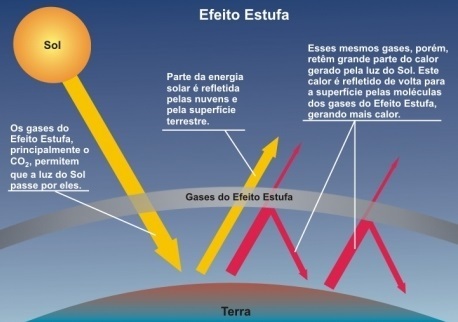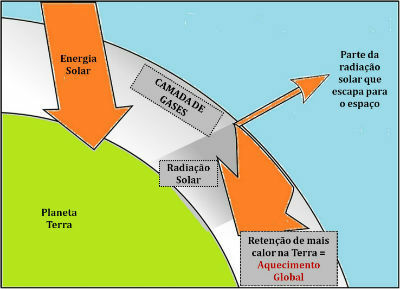The environment is the place where life on earth develops, that is, it is nature with all living and non-living beings that inhabit and interact on it.
In short, the environment encompasses all living and non-living elements that are related to life on Earth. It is everything that surrounds us, such as water, soil, vegetation, climate, animals, human beings, among others.

Environmental Preservation
The preservation of the environment is part of the transversal themes present in the National Curriculum Parameters (PCN's).
Its objective is to encourage students to the importance of preserving the environment and the problems caused by human intervention in nature.
What is the difference between Environmental Preservation and Conservation?
The terms preservation and environmental conservation are constantly confused. However, each of them has a different meaning and goals.
Environmental Preservation: It's protection without human intervention. It means untouchable nature, without the presence of man and without considering the utilitarian and economic value it may have.
Environmental Conservation: It is the protection with rational use of nature, through sustainable management. It allows the presence of man in nature, however, in a harmonious way.
An example of environmental conservation areas are the conservation units. They represent spaces established by law that aim to protect biodiversity, restore ecosystems, protect endangered species and promote sustainable development.
Environment and Sustainability
Currently, environmental issues involve the sustainability. Sustainability is a broad term that also involves planning education, economy and culture to organize a strong, healthy and just society.
Economic, social and environmental sustainability is one of humanity's greatest challenges.
The term sustainability arises from the need to combine economic growth with environmental preservation.
We call this new form of development sustainable development. Its classic concept is that it meets the needs of the present without compromising the possibility of future generations meeting their own needs.
For sustainable development to become a reality, the involvement of all people and nations on the planet is necessary. Actions range from individual attitudes to international agreements.
Environment in Brazil
In Brazil, the National Environmental Policy, Law nº 6.938, of August 31, 1981, defines the instruments for protecting the environment. It is considered the starting point for actions for environmental conservation in Brazil.
Through it, the environment is defined as:
"the set of conditions, laws, influences and interactions of a physical and biological order, which allows, shelters and governs life in all its forms".
The National Environmental Policy aims to preserve, improve and restore the environmental quality conducive to life.
It also aims to ensure conditions for socioeconomic development, national security interests and the protection of the dignity of human life.
The Brazilian Federal Constitution also has an article that deals exclusively with the Environment. Article 225 mentions that:
"Everyone has the right to an ecologically balanced environment, a good for common use by the people and essential to a healthy quality of life..."
Other important environmental laws that protect Brazilian natural resources and promote actions aimed at the conservation and improvement of the quality of life are:
- National Environmental Education Policy - Law No. 9,795 of 1999.
- Environmental Crimes Law - Law No. 9,605 of 1998.
- National Water Resources Policy - Law No. 9433 of 1997.
The agency responsible for environmental actions and policies in Brazil is the Ministry of the Environment (MMA).
International Agreements
Given the urgency and the worldwide concern with environmental problems and the resulting impacts, several international agreements and treaties have emerged. They propose new models for development, reduction of polluting gas emissions and environmental conservation.
The environmental concern has been addressed at the international level since the realization of Stockholm Conference, in 1972. After that, it again gained prominence at the United Nations Conference on Environment and Development (RIO-92 or ECO-92), with the approval of the Agenda 21.
Other important international treaties and agreements aimed at the environment are:
- Montreal Protocol: objective to reduce the emission of products that damage the ozone layer
- Kyoto Protocol: aim to mitigate the impact of environmental problems, for example, climate change on planet earth.
- Rio +10 - World Summit on Sustainable Development: definition of actions aimed at environmental preservation and social aspects, especially in poorer countries.
- Rio +20 - UN Conference on Sustainable Development: reaffirmation of sustainable development combined with environmental preservation.
- Paris Agreement: objective to contain global warming and reduce greenhouse gas emissions.
- 2030 Agenda: aims to guide the nations of the planet towards sustainable development, in addition to eradicating extreme poverty and strengthening world peace.
Environmental education
THE environmental education it corresponds to the processes through which the individual and the community build social values, knowledge, skills, attitudes and competences aimed at environmental conservation.
Its objective is to understand concepts about the environment, sustainability, preservation and conservation.
In addition to building new social values, acquiring knowledge, attitudes, skills and abilities to achieve and maintain the right to a balanced environment.
Environmental problems
In recent decades, the environment has been suffering more and more from human action, one of which is the practice of burning. As this intervention is not always harmonious and sustainable, environmental problems arise.
The main environmental problems of today are:
- Climate changes
- Greenhouse effect
- Global warming
- Water pollution
- Air pollution
- Destruction of the Ozone Layer
- Species extinction
- Acid rain
- Deforestation
- desertification
- Pollution
To may also be interested in: Environmental problems in Brazil
Concepts Related to the Environment
Some important concepts related to the environment are:
- ecosystem: Sets of living (Biotic) and non-living (Abiotic) beings.
- Biotic Beings: Autotrophs (producers) and heterotrophs (consumers), ie plants, animals and microorganisms.
- abiotic beings: These are the physicochemical factors present in an ecosystem, such as water, nutrients, humidity, soil, sunlight, air, gases, temperature, etc.
- Biomes: Set of Ecosystems. It is worth remembering that the biomes that make up Brazil are: Amazon Biomes, Caatinga Biome, Cerrado Biome, Atlantic Forest Biome, Pantanal Biome and the Pampas Biome.
Curiosities
- O World environment day is celebrated on June 5th, a date inspired by the “United Nations Conference on the Human Environment”, held in Stockholm, Sweden, in 1972.
- Pollution Combat Day is celebrated on August 14th.


